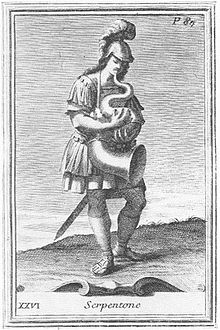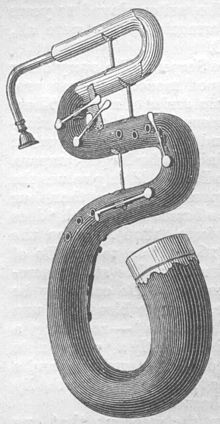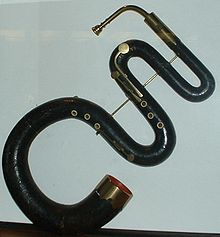- Serpent (instrument)
-
A serpent is a bass wind instrument, descended from the cornett, and a distant ancestor of the tuba, with a mouthpiece like a brass instrument but side holes like a woodwind. It is usually a long cone bent into a snakelike shape, hence the name. The serpent is closely related to the cornett, although it is not part of the cornett family, due to the absence of a thumb hole. It is generally made out of wood, with walnut being a particularly popular choice. The outside is covered with dark brown or black leather. Despite wooden construction and the fact that it has fingerholes rather than valves, it is usually classed as a brass, with the Hornbostel-Sachs scheme of musical instrument classification placing it alongside trumpets.
The serpent's range varies according to the instrument and the player, but typically covers one from two octaves below middle C to at least half an octave above middle C.
Contents
Characteristics
The serpent usually has six holes, which are ordered in two groups of three. On early models, the fingerholes were keyless, like those of a recorder. However, later models added keys as on a clarinet, although they were for additional holes (out of reach of the fingers), while the original holes remained unkeyed, and are to be covered or uncovered directly by the fingers of the player.
While it does not have the kind of rigidly defined fingering system that other wind instruments enjoy, the serpent requires an extraordinary amount of effort from the player, who must select the desired pitch with his or her lips, usually overriding the tone the instrument prefers to sound with any particular fingering. The serpent player also has a unique right-hand finger position, in that the index finger may be further down the tube towards the bell than the other fingers of that hand. In this respect the fingering of the right hand is reversed to that found in all other keyed wind instruments, where the keys and holes controlled by the index fingers are further up towards the mouthpiece than the other fingers. This is because the serpent was originally held vertically, with both of the player's hands oriented palm-down; in this position the right hand fingerings are not reversed in the manner described above. Later, players began to hold the instrument horizontally, necessitating a reversal of the right hand to palm-up, with the fingerings changing accordingly and left.
 A man playing the serpent: Engraving from Filippo Bonanni's Gabinetto Armonico pieno d'Instromenti (Roma, 1723)
A man playing the serpent: Engraving from Filippo Bonanni's Gabinetto Armonico pieno d'Instromenti (Roma, 1723)
History
The instrument is claimed to have been invented by Canon Edmé Guillaume in 1590 in Auxerre, France, and was first used to strengthen the sound of choirs in plainchant. This date for the invention of the serpent did not appear until 1743, in Jean Lebœuf's "Mémoires Concernant l’Histoire Ecclésiastique et Civile d’Auxerre." Herbert Heyde asserts the serpent evolved from a type of bass cornetto and was invented in Italy in the 16th century[1]. Around the middle of the 18th century, it began to be used in military bands and orchestras, but was replaced in the 19th century by a fully keyed brass instrument, the ophicleide, and later on by valved bass brass instruments such as the euphonium and tuba. After that the Serpent dropped off in popularity for a period of time.
Bernard Herrmann used a serpent in the scores of White Witch Doctor and Journey to the Center of the Earth (1959).
In the 1970s instrument-maker Christopher Monk began playing and later making Serpents, and in 1976 he founded the London Serpent Trio. Since then, the instrument has been undergoing a revival of sorts. In 1987 the first concerto for the instrument was written by Simon Proctor. The Serpent Concerto was first performed on October 21, 1989 at the First International Serpent Festival (celebrating the 399th anniversary of the serpent) with Serpent soloist Alan Lumsden. Since that time, the Serpent Concerto has been performed in public on many occasions, most notably by Douglas Yeo of the Boston Symphony Orchestra and Boston Pops Orchestra, who played the solo part with the Boston Pops under the direction of John Williams. The concerto appears on a commercial CD recording "Le Monde du Serpent" (The World of the Serpent), on the Berlioz Historic Brass label, BHB 101, with the Berlioz Historical Brass, Gloria Dei Cantores choir, members of the Boston Symphony Orchestra et al. In 2008, Douglas Yeo premiered another serpent concerto, "Old Dances in New Shoes" by Washington D.C. based composer Gordon Bowie, with the Boston Classical Orchestra conducted by Steven Lipsitt.
Variations
Serpent in the V&A Museum, London.
There are two main types of serpent: curved (serpentine, or double-S, shaped) and straight/upright (the tube is mostly straight, but is folded back on itself in the middle, much like a bassoon). Within the curved style, there are two variations; Church (also called French) and Military (also called English). The Church serpent is the original type, popularized in France, and is distinguished by gentle, sweeping curves and little (if any) metal reinforcements. The Military serpent was primarily made in England, and its characteristics include having tighter bends and a slightly more compact overall size as a result, with lots of metal bands and stays between the tubing. Furthermore, there are several different sizes besides the common "church" Serpent, including Contrabass ("anaconda"), Tenor ("serpent") and Soprano ("worm"). Only the original bass size, and possibly the tenor, were made during the serpent's heyday. The soprano is a fanciful modern variant, and the contrabass is based on a single known original made after the serpent was already fading in popularity.
From its beginning as an instrument held vertically between one's knees with both palms facing down, Hermenge (in his serpent method - Paris, 1817) suggested a horizontal playing position that rested in the right hand palm faced upward. This position was adopted by English military serpents and the instrument was made of a more robust construction (owing to marching or riding on horseback) with thicker walls of the wood and metal stays between the "S" bends of the serpent. The "English bass horn" was a variant on the "cimbasso" (= corno di basso), a form of upright serpent of metal consisting of a tube folded back on itself (rather like the modern bassoon). Mendelssohn scored for the English bass horn in the first edition of his "Midsummer Night's Dream" although the ophicleide was substitituted with his consent after the English bass horn fell rapidly from favor. Coeffet (Paris, active 1810-1845) invented the "ophimonocleide," an upright serpent with six holes and a single key (ophi = serpent, mono = one, kleis = key/covering). Upright serpents called the "basson Russe " (often referred to as the "Russian bassoon") - neither Russian nor a form of bassoon - often had a zoomorphic head like the buccin. The "serpent Forveille'" (pronounced "serpent forvoe" or "forvay" and named after its inventor) featured a small receptacle in the bocal to collect condensation that results from the warm breath of the player. Whereas other upright serpents usually had metal bells and either a metal or wooden body, the Serpent Forveille was half wood on the part from the middle up to the bell, and metal from the middle to the mouthpiece. Gradually keys were added to serpents (the most appear to have been 14, on instruments made by Thomas Key (London, c. 1830) on display at the Museum of Welsh Life in Cardiff, Wales (another specimen is owned but not displayed by the Metropolitan Museum of Art in New York City). The extraordinary contrabass serpent (in nominal CC) made by the Wood brothers in Huddersfield, England, c. 1840) has all of its holes covered by keys but, owing to the varying sizes of the holes and "chimneys" extending from each hole which are in turn covered by flat keys, is really more of a wooden contrabass ophicleide in serpentine shape.
The ophicleide (again, ophis = serpent, kleis = key/covering, therefore "keyed serpent",) was patented in France by Halary in 1821.
Players
- Michel Godard, jazz musician and tubist, who also plays the serpent
See also
References
- ^ H. Heyde, "Zoomorphic and theatrical musical instruments in the late Italian Renaissance and Baroque Eras", in: "Marvels of Sound and Beauty: Italian Baroque Musical Instruments", Florence, 2007
External links
- The Serpent Website - an excellent reference for everything Serpent-related. Complete and detailed.
- Complete Program Notes for "Le Monde du Serpent" - the story of Douglas Yeo's discovery of the Serpent and the recording of his 2003 solo Serpent CD.
- Christopher Monk Instruments - Serpents and many other historical brass instruments are made here.
- Contrabass Serpent - a page devoted to the c. 1840 Contrabass Serpent in the Edinburgh University Collection of Historic Musical Instruments.
- The London Serpent Trio
- serpent.instrument - Serpent french website by Volny Hostiou - : research and informations about church serpent
Categories:- Brass instruments
- Early musical instruments
Wikimedia Foundation. 2010.


